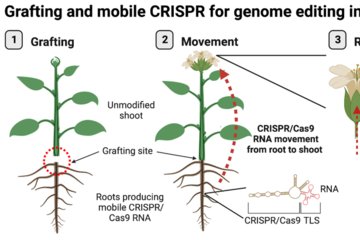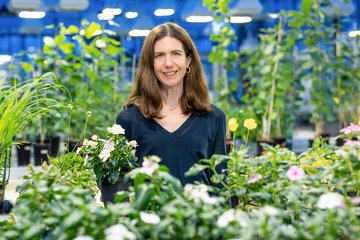High-yielding maize and rice
Researchers discover regulatory slide that controls the number of seeds
At the beginning of the development of useful and cultivated plants by humans about 10,000 years ago was the domestication of wild plants. From the multitude of wild plants in a region, humankind selected those that apparently possessed special properties useful to them, e.g. cereal plants whose seeds remain on the plant longer instead of falling out, or those plants that have more or larger seeds. Through domestication, genetic selection took place, which was associated with trait changes. Independently of each other, convergent development has occurred in different plants in different parts of the world, which is called convergent selection. So far, little is known about convergent selection in cereals. New results by researchers from the Max Planck Institute of Molecular Plant Physiology and colleagues from China on possible yield increases in maize and rice represent an important step towards a better understanding of this phenomenon with possible positive implications for plant breeding.

Cereal crops are important sources of calories for human consumption and have been intensively selected over thousands of years for favorable agronomic traits such as increased grain yield. Grains such as maize and rice are among our most important cultivated plants and cover a large part of the human energy supply. They originate from different regions of the world - maize from Mexico and rice from China - where there are therefore a number of wild relatives of these important crops. For the present study, the genome of maize was compared with that of its wild relative teosinte to determine how domestication and selection have affected the genome.
The scientists were able to identify a gene in which teosinte and cultivated maize differ. The genome sequence analysis showed that an upstream non-coding region of the gene KRN2 (Kernel Row Number 2) has a special function in maize. Upstream non-coding regions of a gene used to be considered "rubbish" because their function was not known. Today we know that such regions regulate the activities of genes. It is precisely this region in the KRN2 gene that was subject to strong selection during domestication and optimization of crop performance. "We were able to show that changes in this region reduced the expression (gene expression) of KRN2, resulting in an increased number of grain rows," Fernie comments on the experiments. The same could be demonstrated for the corresponding gene in rice called OsKRN2. This demonstrates the cross-species importance of this gene during crop domestication.
At the molecular level, KRN2/OsKRN2 encodes a WD40 protein and acts synergistically with a gene of unknown function called DUF1644. This protein interaction is thought to have remained largely unchanged during the selection process and controls grain number in both maize and rice. The importance of such control becomes clear when one realizes that plants need a lot of resources, such as water or nutrients, for seed formation. Therefore, it must be possible to regulate the amount of seeds with regard to the available resources. For the plant, it is primarily important that seeds are formed; for humans, it is primarily important how many seeds are formed. With the non-coding region of the KRN2/OsKRN2 gene, we have discovered the regulatory slide, so to speak, that controls the number of seeds.
Knockout leads to yield increases

Knockout of the KRN2/OsKRN2 genes lead to a yield increase of ten percent and eight percent in maize and rice, respectively. This could be shown over several independent growing seasons in the field and remained without obvious negative effects on other important agronomic traits. This means that other traits, important for the use of the two cereals, are not affected by the change in activity of the KRN2/OsKNRN2 genes. By knockout or by changing the activity of genes, individual traits can be specifically changed or improved. In contrast, when wild relatives are crossed into cultivated plants, a whole series of undesirable traits are found in the offspring in addition to the desired traits, and these have to be removed again at great expense and time. Depending on the plant and the mode of inheritance, it is also possible that some of the undesirable traits cannot be removed at all.
These results show that cereal plants with such a diverse domestication and habitat history were subject to selection for conserved genomic regions, a process known as convergent selection. On a genome-wide scale, a set of 490 orthologous genes - genes found in different organisms whose base sequence remained largely unchanged during evolution or selection processes - were highlighted as being subject to this process, including KRN2. These genes were significantly enriched in starch and sucrose metabolism and in cofactor biosynthesis. Given the demonstrated importance of KRN2, these are promising gene candidates that can be selected to optimize plant production.
Possibilities for the domestication of wild relatives

In the face of current and ongoing climate change, it is a challenge to safeguard the yield potential of elite varieties domesticated over millennia. One way to improve the yield potential of crop plants could be to identify the important "regulatory switches" in crop plants and thus shift gene expression in the desired direction.
For the production of more resistant crop plants, one could take the exact opposite route: through de novo domestication, one could specifically introduce the favorable agronomic traits of the crop plants into the wild plant, which is for the most part better adapted to biotic and abiotic environmental factors. Alisdair R. Fernie, research group leader at the Max Planck Institute of Molecular Plant Physiology in Potsdam-Golm, explains: "We could simply introduce a handful of these domestication genes, like KRN2, into their wild relatives. The idea behind this is that you can breed high-yielding, but also more resistant plants, which will be crucial for agriculture in the future."
URS/Bulut














